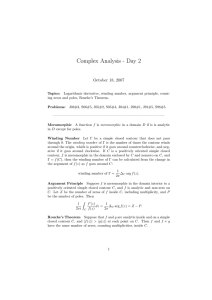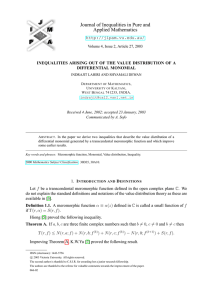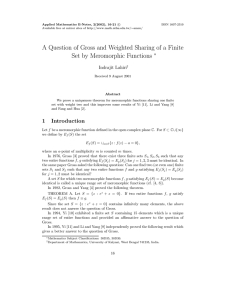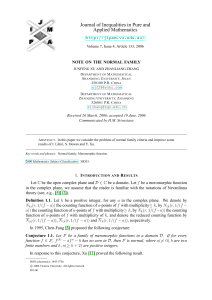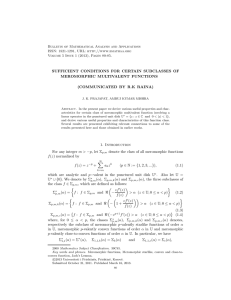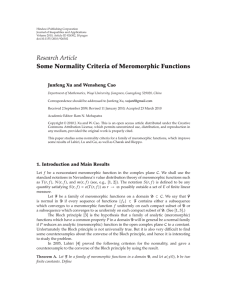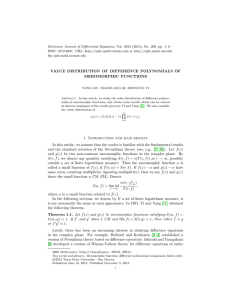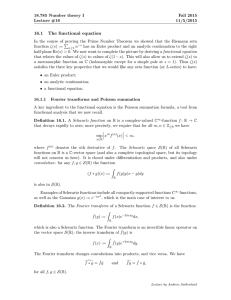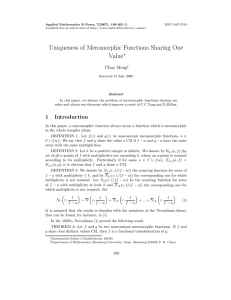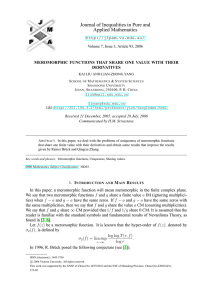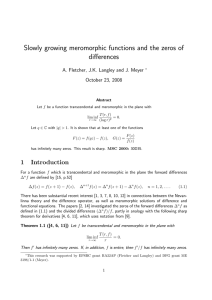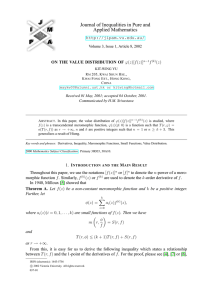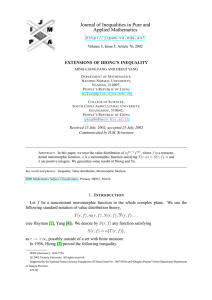CORRIGENDUM TO “NONLINEAR DIFFERENTIAL POLYNOMIALS SHARING A SMALL FUNCTION” [ARCH.
advertisement
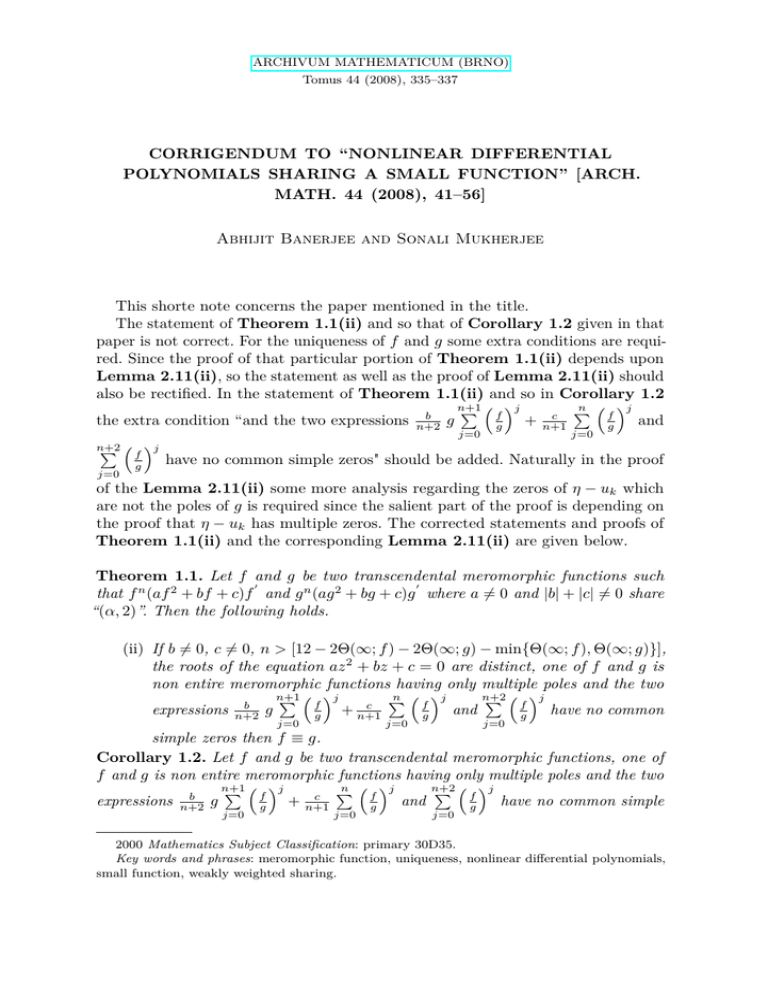
ARCHIVUM MATHEMATICUM (BRNO)
Tomus 44 (2008), 335–337
CORRIGENDUM TO “NONLINEAR DIFFERENTIAL
POLYNOMIALS SHARING A SMALL FUNCTION” [ARCH.
MATH. 44 (2008), 41–56]
Abhijit Banerjee and Sonali Mukherjee
This shorte note concerns the paper mentioned in the title.
The statement of Theorem 1.1(ii) and so that of Corollary 1.2 given in that
paper is not correct. For the uniqueness of f and g some extra conditions are required. Since the proof of that particular portion of Theorem 1.1(ii) depends upon
Lemma 2.11(ii), so the statement as well as the proof of Lemma 2.11(ii) should
also be rectified. In the statement of Theorem 1.1(ii) and so in Corollary 1.2
n+1
n j
P f j
P
f
b
c
the extra condition “and the two expressions n+2
+ n+1
and
g
g
g
j=0
n+2
P
j=0
f
g
j
j=0
have no common simple zeros" should be added. Naturally in the proof
of the Lemma 2.11(ii) some more analysis regarding the zeros of η − uk which
are not the poles of g is required since the salient part of the proof is depending on
the proof that η − uk has multiple zeros. The corrected statements and proofs of
Theorem 1.1(ii) and the corresponding Lemma 2.11(ii) are given below.
Theorem 1.1. Let f and g be two transcendental meromorphic functions such
0
0
that f n (af 2 + bf + c)f and g n (ag 2 + bg + c)g where a 6= 0 and |b| + |c| =
6 0 share
“(α, 2)”. Then the following holds.
(ii) If b 6= 0, c 6= 0, n > [12 − 2Θ(∞; f ) − 2Θ(∞; g) − min{Θ(∞; f ), Θ(∞; g)}],
the roots of the equation az 2 + bz + c = 0 are distinct, one of f and g is
non entire meromorphic functions having only multiple poles and the two
n+1
n j
n+2
P f j
P
P f j
f
b
c
expressions n+2
g
+
and
have no common
g
n+1
g
g
j=0
j=0
j=0
simple zeros then f ≡ g.
Corollary 1.2. Let f and g be two transcendental meromorphic functions, one of
f and g is non entire meromorphic functions having only multiple poles and the two
n+1
n j
n+2
P f j
P
P f j
f
b
c
expressions n+2
g
+ n+1
and
have no common simple
g
g
g
j=0
j=0
j=0
2000 Mathematics Subject Classification: primary 30D35.
Key words and phrases: meromorphic function, uniqueness, nonlinear differential polynomials,
small function, weakly weighted sharing.
336
A. BANERJEE AND S. MUKHERJEE
zeros, such that n > [12 − 2Θ(∞; f ) − 2Θ(∞; g) − min{Θ(∞; f ), Θ(∞; g)}] be an
0
0
integer. If af n (f − β1 )(f − β2 )f and ag n (g − β1 )(g − β2 )g share “(α, 2)”, where
β1 and β2 are the distinct roots of the equation az 2 + bz + c = 0 with |β1 | 6= |β2 |,
then f ≡ g.
Lemma 2.11. Let F and G be given as in Lemma 2.9 and n(≥ 6) be an integer.
Suppose F ≡ G. Then the following holds.
(ii) If b =
6 0, c 6= 0, and the roots of the equation az 2 + bz + c = 0 are distinct and one of f and g is non entire meromorphic function having only
n+1
n j
P f j
P
f
b
c
multiple poles and the two expressions n+2
g
+
and
g
n+1
g
j=0
n+2
P
j=0
f
g
j
j=0
have no common simple zero then f ≡ g.
Proof. Case 2. Suppose b 6= 0 and c 6= 0. Then F ≡ G implies
(1)
Af n+3 + Bf n+2 + Cf n+1 ≡ Ag n+3 + Bg n+2 + Cg n+1 ,
a
where A = n+3
,B=
Let us assume f 6≡ g.
b
n+2
and C =
c
n+1 .
Subcase 2.1. Suppose the roots of the equation az 2 + bz + c = 0 are distinct.
Since (1) implies f , g share (∞, ∞) without loss of generality we may assume that
g has some multiple poles. Putting η = fg in (1) we get
Ag 2 (η n+3 − 1) + Bg(η n+2 − 1) + C(η n+1 − 1) ≡ 0 .
i.e.,
(2)
Ag 2 ≡ −Bg
η n+1 − 1
η n+2 − 1
−
C
.
η n+3 − 1
η n+3 − 1
First we observe that since a meromorphic function can not have more than two
Picard exceptional values, η takes at least n values among uk = exp( 2kπi
n+3 ) where
k = 1, 2, . . . , n + 2.
Let z0 be a pole of g with multiplicity p(≥ 2), which is not a root of η − uk = 0.
Then from (2) we have
2p = p i.e., p = 0 ,
which is impossible.
Hence from (2) we see that the poles of g are precisely the roots of η − uk = 0.
Suppose z1 is a zero of η−uk of multiplicity r which is a pole of g with multiplicity
s (say) then from (2) we see that
2s = r + s
i.e.,
r = s.
Since g has no simple pole, it follows that such points are multiple zeros of η − uk .
CORRIGENDUM
337
From (2) we know
Bg
Ag 2 ≡ −
(3)
n+1
P
ηj + C
j=0
n
P
j=0
n+2
P
ηj
.
ηj
j=0
Suppose z2 be a simple zero of η − uk where k = 1, 2, . . . , n + 2, which is a zero of
multiplicity q(≥ 2) of the numerator of (3). Then from (3), z2 would be a zero of
n
n
P
P
η j . Since
η j and
order q − 1 of g 2 . So it follows that z2 would be a zero of
j=0
n+2
P
j=0
j
η may have at most one common factor, we see that η − uk has multiple zeros
j=0
for at least n − 1 values of k ∈ {1, 2, . . . , n + 2}. Hence
1
Θ(uk ; η) ≥ ,
2
for at least n − 1 values of k, which implies a contradiction as n ≥ 6.
Department of Mathematics, Kalyani Government Engineering College
West Bengal 741235, India
E-mail: abanerjee_kal@yahoo.co.in, abanerjee_kal@rediffmail.com
![Mathematics 414 2003–04 Exercises 5 [Due Monday February 16th, 2004.]](http://s2.studylib.net/store/data/010415766_1-b65af2bb66ab8e422354912dcedcb6a6-300x300.png)




